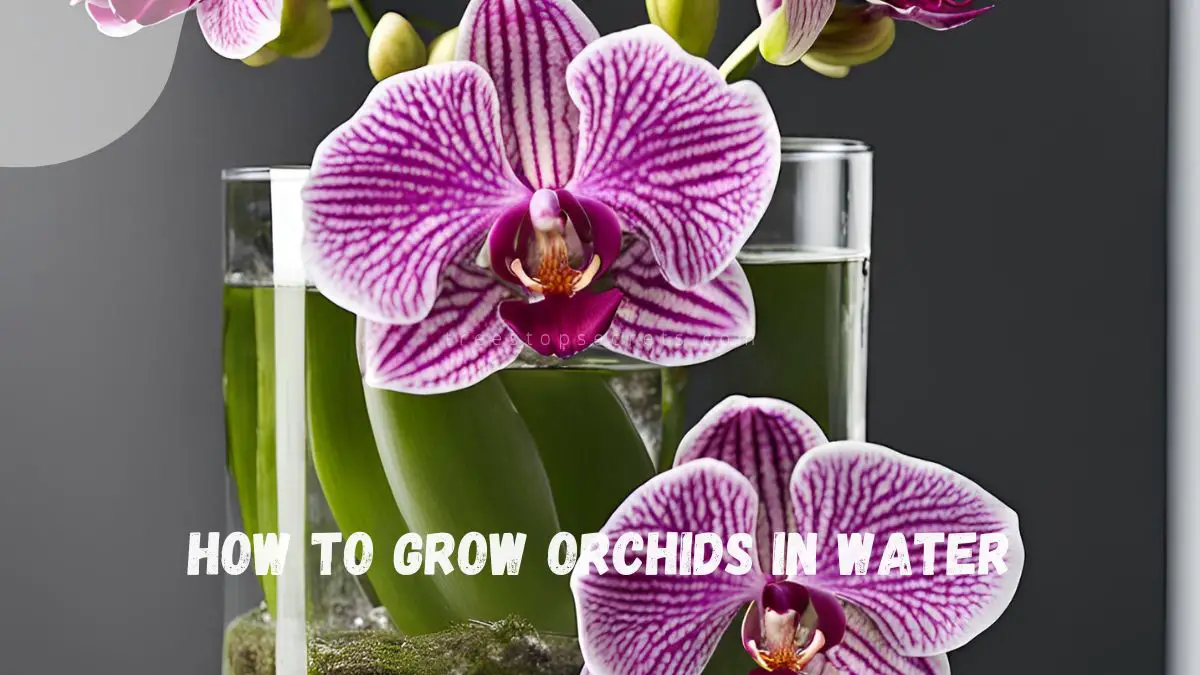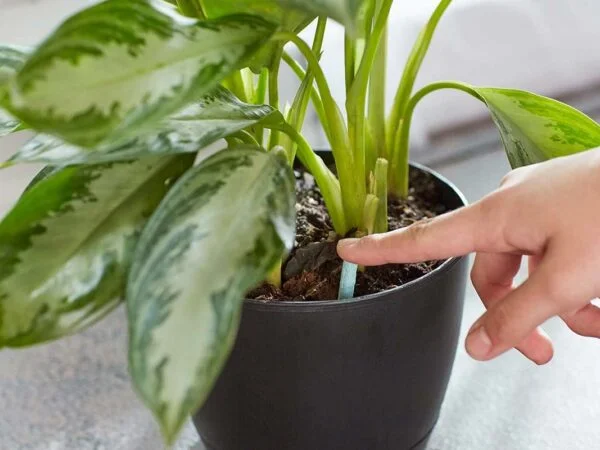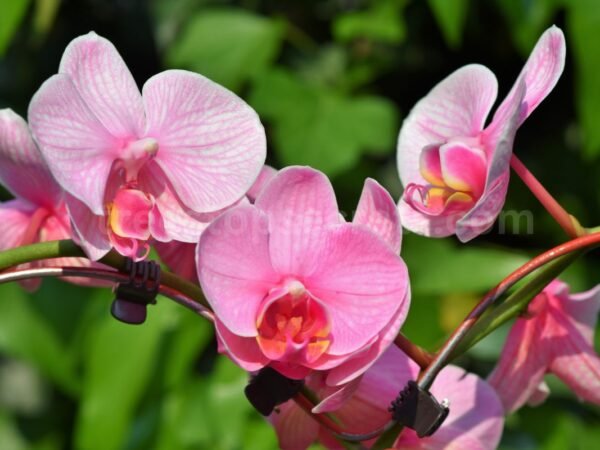Did you know that orchids can thrive in water alone, without the need for soil? This surprising fact opens up a whole new world of possibilities for orchid enthusiasts looking to simplify their care routine. Growing orchids in water is not only convenient but also offers a unique and visually stunning way to display these delicate flowers. In this post, we will explore the ins and outs of how to successfully grow orchids in water, from selecting the right type of orchid to providing proper care and maintenance tips. Whether you're a seasoned orchid grower or a beginner looking to try something new, this guide will equip you with the knowledge needed to cultivate beautiful orchids in water.
Key Takeaways
- Start with the Right Container: Choose a container that allows for proper drainage and aeration to prevent root rot.
- Regularly Monitor and Adjust: Keep an eye on your orchids in water culture, adjusting water levels and conditions as needed for optimal growth.
- Choose the Correct Fertilizer: Select a balanced fertilizer specifically designed for orchids to provide essential nutrients.
- Maintain Consistent Care: Regularly check on your orchids, ensuring they have adequate light, humidity, and temperature levels.
- Transition Carefully: When transitioning orchids to water culture, monitor their progress closely and make adjustments gradually.
- Stay Patient and Observant: Patience is key in growing orchids in water; observe changes in your plants and adjust care accordingly.
Benefits of Water Culture
Easy Care
Choosing orchids that thrive in water simplifies care tasks. Maintaining consistent water levels is crucial. Regularly monitoring orchids helps detect and address any stress or issues promptly.
Pest Reduction
Implementing water culture effectively reduces the risk of pest infestations. Regular root checks are essential to catch any signs of pests early. Natural pest control methods can help prevent pest issues efficiently.
Root Health
Ensuring proper aeration and moisture levels is key to maintaining optimal root health. Monitoring root color and texture provides insights into their condition. Trimming unhealthy roots is necessary for sustaining overall root health.
Plant Growth
Adequate water and nutrient supply are vital for promoting healthy plant growth. Comparing orchid growth rates in water versus traditional methods offers valuable insights. Optimizing plant growth involves adjusting water levels and nutrient intake accordingly.
Challenges and Solutions
Supporting Plants
When growing orchids in water, consider companion plants that can provide support. Choose plants with similar water and light needs to ensure harmonious growth. Avoid overcrowding the plants to prevent resource competition.
- Select companion plants wisely
- Prevent overcrowding for optimal growth
Transitioning Slowly
Gradually transition orchids into water culture to minimize shock. Monitor their response closely during this period. Adjust the watering schedule as needed to facilitate a smooth transition.
- Transition orchids gradually
- Monitor responses closely
Monitoring Roots
Regularly inspect the roots for signs of stress or disease to maintain plant health. Keep track of root growth and development over time. Adjust the watering frequency based on the health and growth of the roots.
- Inspect roots regularly
- Track root growth and adjust watering
Choosing the Right Container
Size Matters
When growing orchids in water, select appropriate container sizes depending on the orchid's root system. Ensure the container is not too small to restrict root growth. Consider the orchid's size and growth pattern to determine the ideal container size.
To promote healthy root development, ensure the container allows ample room for root expansion and growth. Root-bound orchids can suffer from stunted growth and nutrient deficiencies. Providing sufficient space for roots to spread out will enhance their overall health.
Consider the specific needs of your orchid when choosing a container. Some orchids have extensive root systems that require larger containers, while others may thrive in smaller ones. Tailoring the container size to your orchid's individual requirements is crucial for successful growth.
Material Considerations
Opt for glass containers when growing orchids in water. Glass allows you to observe root growth and monitor the plant's health easily. This transparency enables you to detect any issues early on and take necessary actions to address them promptly.
When setting up your orchid in a water-growing system, consider placing clay pebbles at the bottom of the container. These pebbles provide stability and support for the roots, preventing them from becoming waterlogged or sitting in stagnant water. This setup promotes proper aeration and drainage for the roots.
Avoid using containers made from materials that could potentially leach harmful chemicals into the water. Orchids are sensitive plants that can be negatively impacted by toxic substances present in certain plastics or metals. Opting for containers made from safe materials ensures the overall well-being of your orchid.
Types of Water Culture
Full Water Culture
Fully submerge orchids in water to provide continuous hydration and nutrients. Monitor the water quality regularly to ensure it remains clear and free from contaminants. Adjust the water levels as needed to maintain the ideal growing conditions for orchids.
Semi-Water Culture
Implement semi-water culture for orchids that thrive with periodic dry periods. Alternate between wet and dry phases to simulate their natural habitat conditions. Observe how orchids respond to this culture method and make necessary adjustments based on their feedback.
Semi-Hydroponic
Experiment with semi-hydroponic systems for cultivating orchids in water. These setups involve providing aeration and nutrient solutions to support orchid growth. Keep a close eye on the nutrient levels and the health of the roots within semi-hydroponic systems.
Setting Up Your Water Culture
Starting with Roots
Begin the water culture process by preparing orchid roots. Rinse and clean roots before transitioning to water culture. Ensure roots are healthy and free from any signs of damage.
Container Preparation
Prepare containers by adding clay pebbles for root support. Clean containers thoroughly before placing orchids in water. Choose transparent containers for easy monitoring of root health.
Water Selection
Use rainwater or distilled water for orchids in water culture. Avoid tap water to prevent mineral buildup and root damage. Maintain consistent water quality to promote orchid health.
Fertilizing Techniques
Fertilizer Types
When growing orchids in water, it's crucial to choose suitable fertilizers that cater to their specific needs. Opt for balanced fertilizers designed for orchids to ensure they receive all essential nutrients. These fertilizers typically contain a mix of nitrogen, phosphorus, and potassium to support healthy growth.
To prevent nutrient imbalances, avoid over-fertilization. Excessive amounts of fertilizer can harm orchids in water culture by causing salt buildup in the growing medium. This buildup can lead to root damage and hinder the plant's ability to absorb water and nutrients effectively.
Fertilizing Frequency
Establishing a regular fertilizing schedule is key to maintaining the health of orchids growing in water. Monitor the plant's response to fertilization closely and make any necessary adjustments to the frequency or dosage. By observing how the orchid reacts to the fertilizer, you can ensure it receives adequate nutrition without being overwhelmed.
Adjust the fertilizing frequency based on the growth and overall health of the orchid. During periods of active growth, such as when the plant is producing new leaves or roots, it may require more frequent fertilization. Conversely, when growth slows down or the plant enters a dormant phase, reduce the frequency to avoid overfeeding.
Maintaining Your Orchids
Submerging Duration
Determining the optimal submerging duration for your orchids is crucial. Different orchid types may require varying soaking periods. Experiment with different durations to find the ideal soaking time for your specific orchid species. Keep a close eye on your orchids' health and growth during these submerging periods to ensure they are thriving.
When growing orchids in water, it's essential to regularly monitor the duration of submerging. By adjusting the soaking periods, you can cater to the unique needs of each orchid type. This proactive approach allows you to optimize their growth and overall well-being.
To maintain healthy orchids, it's important to monitor and adjust their care routine regularly. Check for any changes in their appearance or behavior, as this could indicate underlying issues. Be prepared to adjust water levels, nutrients, and light exposure based on your observations.
Monitoring and Adjusting
Regularly observing your orchids will help you identify any potential problems early on. By staying vigilant, you can address issues promptly before they escalate. Adjusting the water levels, nutrients, and light exposure based on your orchids' needs is key to ensuring their continued health and vitality.
In water culture, orchids are susceptible to stress and nutrient deficiencies. By responding promptly to any signs of distress, you can prevent more severe problems from developing. Being proactive in monitoring and adjusting your orchids' care regimen will contribute to their long-term success.
- Pros:
- Allows for customization based on individual orchid needs.
- Helps optimize orchid growth and health.
- Cons:
- Requires consistent monitoring and adjustment.
- May involve some trial and error to determine the ideal submerging duration.
Special Care Tips
Kelp Usage
Kelp extracts serve as natural supplements for orchids, promoting growth and blooming. Orchids respond well to the nutrients present in kelp, enhancing their overall health. By incorporating kelp into your care routine, you can observe improvements in your orchid's vitality and resilience.
- Pros: Enhances orchid growth, provides essential nutrients, promotes blooming.
- Cons: Overuse may lead to nutrient imbalances, requires careful monitoring.
Consider starting with a diluted kelp solution to gauge your orchid's reaction before adjusting the concentration. Regularly observe your orchid's response to the kelp treatment to ensure it is positively impacting its growth. Make necessary adjustments based on how your orchid is thriving.
Seasonal Adjustments
Adapting to seasonal changes is crucial in maintaining healthy orchids. As seasons shift, vary water levels and light exposure accordingly. During colder months, reduce watering frequency to prevent overhydration. Conversely, in warmer seasons, increase watering but ensure proper drainage to avoid root rot.
- Spring: Increase watering frequency as temperatures rise for optimal growth.
- Summer: Provide ample shade during peak sunlight hours to prevent sunburn.
- Fall: Gradually reduce watering as temperatures cool to prepare for dormancy.
- Winter: Limit watering and provide adequate warmth to protect against frost damage.
Monitor your orchid's behavior closely during each season transition. Observe any changes in growth patterns or flowering cycles as indicators of whether your care routine requires adjustments. By staying attuned to your orchid's needs throughout the year, you can ensure its longevity and vibrancy.
When to Transition to Water Culture
Identifying Signs
- Learn to identify common signs of stress, disease, and nutrient deficiencies.
- Monitor leaf color, texture, and root health for indicators of plant health.
- Take prompt action when identifying any signs of issues in orchids.
Suitable Orchids
- Choose orchid species that are well-suited for water culture.
- Research different orchid varieties to find those adaptable to water growth.
- Consider the specific care requirements of each orchid species before selecting for water culture.
Summary
You've now discovered the ins and outs of growing orchids in water, from the benefits it offers to the challenges you might face. Choosing the right container, understanding different water culture types, and mastering the setup and maintenance are crucial steps in this process. By following the provided tips and tricks, you can ensure your orchids thrive in a water culture environment, enhancing their growth and beauty.
Embrace the knowledge gained here and embark on your water culture orchid journey with confidence. Experiment with different techniques, stay attentive to your plants' needs, and enjoy the rewarding experience of watching your orchids flourish in water. Your dedication will undoubtedly lead to a stunning orchid display that will be the envy of all who see it.
Frequently Asked Questions
How does water culture benefit orchid growth?
Water culture benefits orchids by providing consistent moisture and nutrients, promoting healthy root growth, and reducing the risk of overwatering. It also helps in preventing root rot and simplifies watering routines.
What are the common challenges faced in growing orchids in water?
Common challenges include maintaining proper nutrient levels, preventing algae growth, ensuring adequate aeration for roots, and monitoring water quality to avoid salt buildup. These challenges can be addressed through proper container selection and regular maintenance.
Which container is best for growing orchids in water?
Choose a clear glass or plastic container to allow light penetration for photosynthesis. Select a container with a narrow neck to support the orchid stem and keep the roots submerged. Ensure the container has drainage holes to prevent water stagnation.
What are the different types of water culture methods for orchids?
Common types of water culture include full-water culture, semi-water culture (semi-hydroponics), and passive hydroponics. Each method varies in the level of water exposure to roots and requires specific care routines. Choose a method based on your orchid species and environmental conditions.
How do you transition orchids to water culture effectively?
Gradually transition orchids to water culture by acclimating them to increased water exposure over several weeks. Start with shorter intervals of water immersion, monitor plant response, and adjust watering frequency accordingly. Ensure proper aeration and maintain optimal humidity levels during the transition period.
Image Source: Paid image from CANVA





